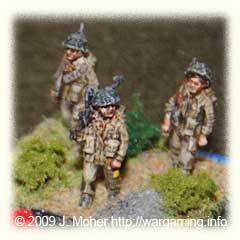
What was it?
World Crossfire Day grew out of the desire of a large group of Crossfire players from around the world to do something to promote the rule set we all love; Crossfire. After discussing numerous alternatives it was decided the best way to promote the rules and to do something special that no one may have done before was to have a World Crossfire Day, and get people in as many countries as possible all playing Crossfire on the same day in local time – and after talking about it for a few months we arbitrarily settled on Saturday 04 April 2009 as a suitable date – mostly thanks to Nikolas Lloyd taking a decisive lead in the organisation of the event.
What then grew from this was a desire to do something more connected and with far more interaction between the games.
Why just have everyone playing their own games anywhere and anyhow when we could link them altogether into a much grander scheme of global scope – and so the World Crossfire Day Campaign was born!
Where was it?
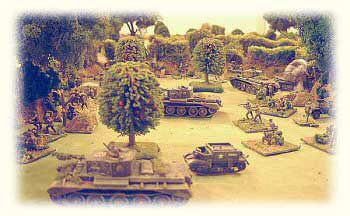
Our hope & plan was to have a series of linked games covering as many countries of the world as possible – we were planning for about 8-10 countries as a minimum (if you count the UK as 1 region – no offence intended), in the end we achieved 7. The games started in New Zealand (unfortunately we didn’t find anyone in Australia who wanted to be involved) and then moving on through Asia (we had games in Malaysia & Hong Kong; we had hoped to include Singapore & India – as there are Crossfire gamers there – but in the end were unable to). Games then moved on to the UK & Europe (only Spain was represented from the latter – we had hoped for France and/or Belgium and/or Holland to also be represented as they all have Crossfire gamers), until finally games moved to Canada and the USA and any other countries in the Americas.
How many games were there?
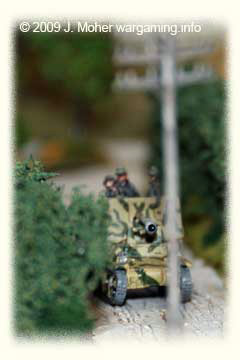
Initially we had hoped for around 24 games – in the end we got about 75% of the way there. It was also initially expected there would be one game as a demo at the Sheffield Wargames Society Triples Wargaming Show which was running on the same day in the UK – but unfortunately this fell through just a couple of weeks prior to the big day. So in the end we ended up with 19 Games which still wasn’t a bad effort. It did require players to be committed to both ensuring they played the game, and also that they completed it in the time slot agreed and got their results back to the organiser on time, so they could be incorporated into the next games…
Due to the time zones the 19 games would actually cover about 36 real hours, all on the 04 April 2009! The following is the time zones covered and number of games.
- GMT +12: New Zealand (2 Games)
- GMT +08: Hong Kong (1 Game)
- GMT +08: Malaysia (2 Games)
- GMT +01: Spain (1 Game)
- GMT +00: United Kingdom (7 Games)
- GMT-04 to -05: Atlantic/Eastern Canada & USA (3 Games)
- GMT-06 to -07: Central/Mountain Canada & USA (2 Games)
- GMT -08: Pacific/Western Canada & USA (1 Game)
Who was Involved?
There were 53 People across 7 Countries involved – including the Campaign Organiser/Scenario Designer.
The Campaign & Scenarios
![German Infantry advancing under fire [AB Figures]. German Infantry advancing under fire - AB Figures.](https://wargaming.info/wordpress/wp-content/uploads/ww2/wcfd2009/wcfd002.jpg)
World Crossfire Day was designed as a full mini-campaign of linked scenarios across North-Western Europe in 1944 with Allied forces such as British, Canadians, and Americans, taking on various German formations as they jointly attempt to defeat them… The campaign was based around a stylised Saint-Lô & Falaise or similar ‘pocket’ series of envelopment battles, but set slightly later as the German retreat from Normandy has already begun. Allied forces would be trying to close in on and/or get around behind the German forces and put as many of them as possible ‘in the bag’. Games were linked and results impacted subsequent games possibly causing reinforcements to arrive early or not at all, or the loss of intended armoured or artillery support (due to being lost or seriously impacted in a previous game), or the reduction of the number of defenders due to failure to delay the attackers long enough or so on.
So each team of players won’t know exactly what state their forces will be in or what is actually available until just before their game, and the later the game the more variable the result – the last 4 games likely to be involved affairs as the various forces in various conditions come together for the final climactic battles!
The following is the actual general situation briefing given to all players:
It is 1944 and the Germans are on the retreat. Allied forces are pressing forwards and hoping to encircle pockets of the enemy and force surrenders on a large scale. The Germans, though being forced back, are still resisting well, and have not collapsed. Every game of the WCFD campaign will have some knock-on consequence for later games. Both sides must conserve forces and resources, and yet both are pressed for time. The allies must advance quickly if they are to catch large numbers of Germans before they can retreat and regroup. The Germans must react to the changing situation rapidly to ensure that they are not encircled. Achieving objectives quickly can never hurt, and can make a great difference to either side’s chances of success in later games. Commanders will not be told in advance what the knock-on consequences of their games will be. You will find out what good (or bad) you did in after-action reports.
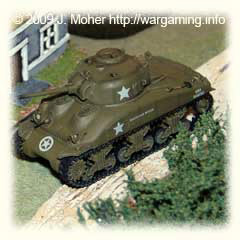
You can read the brief news summaries and Victory Point results of each game more or less exactly as they were posted on the day here.
Kieran and I were involved in the first game of the ‘day’, played here in Auckland, while North of Auckland Errol Hooker and the Whangarei Wargamers kicked off Game 2 of WCFD about 30 minutes after us.
All 19 WCFD 2009 Campaign Games Summarised – Read a brief summary of each game and the Result & Victory Points – will the Allies succeed in snaring the Germans?! And/or read the full reports for most of the games:
- WCFD 2009 – Game 1 Report – Here’s the report of our game in World Crossfire Day 2009.
- WCFD 2009 – Game 2 Report – located here at Wargaming.info.
- WCFD 2009 – Game 4 Report – located at the Hong Kong Society of Wargamers.
- WCFD 2009 – Game 6 Report – located at Matakishi’s Teahouse.
- WCFD 2009 – Game 8 Report – in Steven Thomas’ Balagan.
- WCFD 2009 – Game 9 Report – located here at Wargaming.info.
- WCFD 2009 – Game 10A Report & Game 10B Report at LittleSoldiers.net.
- WCFD 2009 – Game 11 Report & Game 15 Report – on Flickr.
- WCFD 2009 – Game 13 Report – at Tim Marshal’s site.
- WCFD 2009 – Games 16 & 17 Reports – located at Edmonton Wargames Group.
- WCFD 2009 – Game 18 Report – located here at Wargaming.info.
What’s Next?
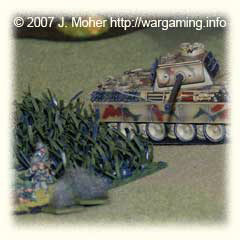
Miniature Wargames Magazine have published an article on the event (written by the organiser Nikolas Lloyd) in issue 316 (August 2009). You can also read more on World Crossfire Day from the organiser, at Nikolas Lloyd’s own World Crossfire Day Page.
Special Thanks
And most importantly a big thanks to Nikolas Lloyd (or ‘Lloyd’ as most people know him) who designed every scenario for all 19 games and not only linked them all together (including the results of each game affecting the next and so on), but who co-ordinated single-handedly with everyone, and who did a 36 hour day “on the day” to manage and control the whole event globally! Well done Lloyd! This is an event that succeeded by the huge effort and commitment of Lloyd to organise, and also by that of all the participants who committed themselves to ensure the games got played at the times planned and results were fed back to Lloyd on time – a great effort and a sign of what a great global community and following Crossfire has!
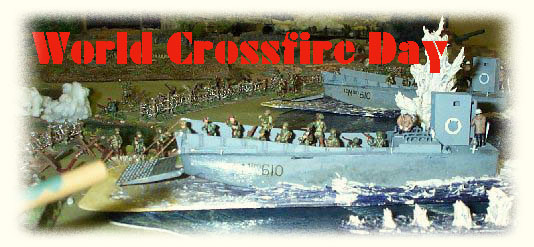
More World Crossfire Day
The following are websites of some of the people who participated:
- Nikolas Lloyd (WCFD Organiser).
- Tim Marshall.
- Steven Thomas.
- Paul Ward (Matakishi’s Tea House).
5 thoughts on “World Crossfire Day 2009”